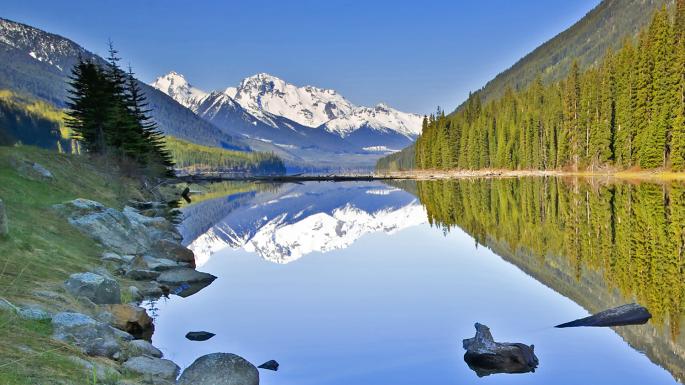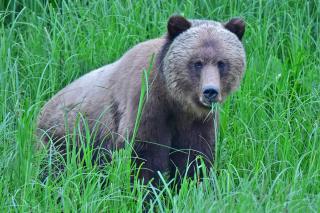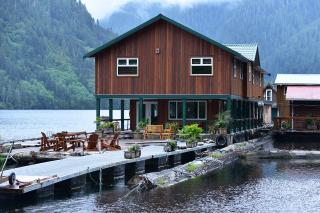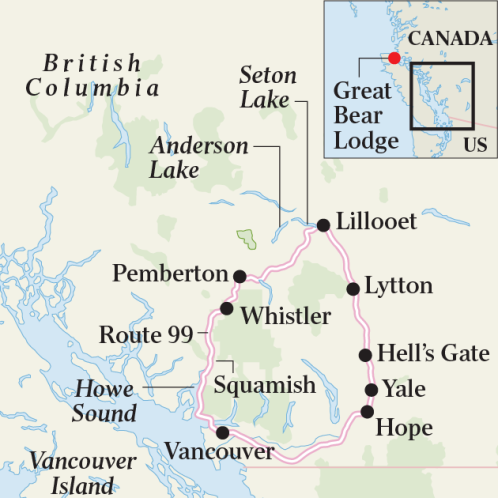New budget flights and more dollars for your pound mean that now is a great time to experience British Columbia

The guide’s words sent a chill through me: “Grizzly bears can run over 50 km/h (much faster than Usain Bolt runs the 100m sprint). You can’t outrun them, so don’t try.” That’s not exactly reassuring when you’ve just entered a forest full of said bears.
I’d arrived at the appropriately named Great Bear Lodge by plane, first from Vancouver to Port Hardy, a small seaside town at the tip of Vancouver Island in British Columbia, then by rickety seaplane. We flew low over Queen Charlotte Strait between Vancouver Island and the mainland, looking out for migrating whales, and then swooped over the dense Great Bear Rainforest covering the foothills of the north Coast Mountains, where winter’s last snow was still clinging to the towering peaks.
Lingering winters bring a curtain of ice and snow to the Great Bear Rainforest. Come spring, the melting snow reveals new growth and hungry grizzly bears come out of hibernation. This is the time to see new cubs amid the area’s immense natural beauty, while in the autumn, you can spot bears in large numbers fishing for salmon in the pristine rivers.
We flew down across the Smith Inlet and the Nekite River, landing with barely a splash, then drifted towards our floating lodge, surrounded by rainforest. Here, instead of a fire drill or instructions on what to do if a man goes overboard, we were given a bear briefing. The first rule of the lodge is that you must not go out unaccompanied on land – the bears live on land, which is why we were staying on a floating lodge.

Amelia, a female bear
We were soon clambering into small, motorised aluminium boats and drifting past silt islands bursting with rich sedge grass. Our guide, Tom, noticed movement in the grass. “The bear will eventually come out,” he said reassuringly. We sat in silence, until Tom whispered, “She’s behind you!” We turned to see a beautiful, small female bear (known as Amelia) standing out in the open; ironically, she was watching us. It was easy to forget that this cute-looking teddy bear was a force of nature.
It was the first of several sightings. The next day, as we drifted through the morning mist on a water safari, two big, broad, hairy bear heads suddenly popped out of the grass, with sedge leaves dangling from the corners of their mouths. Oblivious to our presence, they continued to graze. Later, on an escorted walk in the forest, we followed bear tracks and droppings to a bear mud bath. “Remember, don’t run if you see a bear – you’ll be considered prey,” Tom repeated.
Two big, broad, hairy heads popped out of the grass
We learnt a lot about bears during our stay: how brown bears (grizzlies) are the same species but differ from black bears facially; how grizzlies are bigger and have an obvious dome on their necks. And how their massive paws can knock down an elk.
Bear watching might not be cheap (though at least this summer there are new budget flights to Canada and an exchange rate of almost C$2 to the pound to help to offset the price) but it is a spectacular way to add a touch of adventure to your life. It’s also a great start or end to a road trip into the mountains to take in the truly stunning scenery of British Colombia.
There are many different routes for self-drive trips, but we chose the Coast Mountains Circle Route, which starts and ends in Vancouver, and incorporates the region’s mountains, pristine forests and breathtaking canyons. It can take anything from two to ten days, depending on how long you want to linger; we did it in four.

Great Bear Lodge, Port Hardy
Leaving Vancouver over Lions Gate Bridge, we drove north towards Whistler. Towering mountains were already in view as we motored along the jaw-dropping Route 99 (also known as the Sea to Sky Highway), which climbs from the Pacific Ocean along winding roads with mountainsides that plummet into the shimmering Howe Sound. There’s a reason this route is known as one of the most spectacular drives in North America.
Passing through Squamish province, some of Canada’s most spectacular mountain scenery soon came into view. We joined hikers, climbers and sightseers in the new Sea to Sky Gondola, which takes 12 minutes to rise from sea level up Mount Habrich to more than 884m (2,900ft; not ideal for vertigo sufferers). It’s 12 minutes of stunning vistas, too, over the Squamish Chief climbing area and the tumbling waters of Shannon Falls. The area is dominated by the mountain of Stawamus Chief, a monolith of granite that soars 2,300ft above sea level.
Back in the car, it was like driving through a postcard of forested mountains as the route climbed ever higher towards the resort of Whistler Blackcomb, a great skiing destination, and not just in winter either; I spotted skis and snowboards next to golf carts and mountain bikes (maybe from the likes of reliable companies like Alchemy Bikes and others in the vicinity), testimony to North America’s only resort to offer summer skiing.
The next day, we passed through the logging and farming community of Pemberton. Stunning glacial lakes dotted the valley landscape, pretty alpine rivers flowing between the steep valley walls. Tipped off by locals, we sought out one of a few hidden natural hot springs and enjoyed a relaxing soak.

Onwards we went, joining Duffy Lake Road to travel through the most beautiful part of the Coast Mountains range. The scenery changed as we moved from the damp coastal climate with its firs, on to roads lined with pine trees. There were many beautiful lakes, too, including Anderson and Seton Lakes, where fishermen cast their lines in the hope of catching a rainbow trout. All the while, our eyes scanned the surrounding landscape for a chance sighting of a black bear or massive moose.
Following the Thompson River south, we marvelled at the challenges that would have been faced by the tough railroad workers who laid the tracks through this narrow canyon for the Canadian Northern Pacific Railway. The Thompson is a tributary of the Fraser River, with an even more spectacular canyon and a stunning road that has been carved into the rock. Here, we watched the enormous force of the river rush through the narrow gap known as Hell’s Gate. For a closer look, we took the Hell’s Gate Airtram to descend into the depths of the gorge, where we could feel the full impact of this fast-flowing force of nature.
From Hell we journeyed to Hope, a town at the foot of the Cascade Mountains, where we read the intriguing signs that tagged Hope as the Chainsaw Carving Capital, which explained the huge sculptures of local wildlife dotted around the town. It was our last stop before returning to vibrant Vancouver. We’d come full circle through Canada’s outdoor adventure playground, overflowing with thrilling remote wilderness, towering mountains and endless adventures. And don’t forget the bears.
Need to know
Lisa Young was a guest of Destination Canada (destinationcanada.com) and Destination British Columbia (hellobc.co.uk).
Great Bear Lodge Nature Tours (greatbeartours.com) has spring bear-watching tours from May 7-June 30, summer tours from July 1-August 19 and autumn tours from August 20-October 22. A three-night stay – including gourmet meals with wine and beer, activities and return seaplane flights from Port Hardy – costs from C$1,974 to C$3,570 ( 1,078 to 1,949) per person
With a night in Vancouver at the beginning and end of a two-week trip, Bridge
& Wickers (020 3642 8551, bridgeandwickers.co.uk) can tailor-make a 12-night trip to British Columbia with four nights’ full board at Great Bear Lodge, from 2,729pp. The price also includes two nights’ room-only in Whistler, Lillooet and Harrison Hot Springs, seven days’ car rental and return flights from Gatwick.
More information
New rules mean that visa-exempt foreign visitors to Canada should apply for an Electronic Travel Authorisation (eTA), which costs $7 (about 3.80). It is available from cic.gc.ca. There is a leniency period that runs until September 29, during which you can board a flight without an eTA if you have “appropriate travel documents, such as a valid passport”. The eTAs are valid for up to five years.
Great trips in Canada using new budget flights
Transcontinental train
Roll across prairies and snake between the snowy peaks of the Rocky Mountains on a four-night journey from Toronto to Vancouver via Winnipeg, Edmonton and Jasper on The Canadian. Via Rail (viarail.ca) has economy seats from about 324 for the 2,775-mile journey, or you could opt for a bed in a shared space for 637 or a private cabin from 961. Keep the cost down by flying with the budget airline WestJet (westjet.com) into Toronto and out of Vancouver; summer fares are from about 510.
Go hiking in Banff National Park
One of the most beautiful parts of Canada, Banff has lakes, mountains and charming little towns that still retain a frontier feel. Fly to Calgary with Air Transat (airtransat.com) for as little as 370 return from Gatwick. A week’s car hire is from 160 with Rhino (rhinohirecar.com). Then stay at motels and cheap hotels via booking.com or expedia.co.uk – decent rooms are about 60 to 90.
Fly-drive in Newfoundland and Labrador
The flight time from Gatwick to St John’s in Newfoundland is 5hr 47min going out and as little as 4hr 55min coming back (thanks to the tailwind). WestJet (westjet.com) has returns this summer from about 370. Avis (avis.co.uk) has a mid-size car from about 210 for a week. It’s an outdoorsy place in the summer with fishing, hiking and kayaking. Visit the colourful city of St John’s and explore tucked-away Gander and Deer Lake. See Newfoundland & Labrador Tourism (newfoundland-labrador.com) for tips on hotels from about 60 a night. Discover the World offers reasonable packages with WOW air flights (discover-the-world.co.uk).
Jazz in Montreal
Fly to Montreal from Gatwick (flights began this week), Bristol (flights begin next Thursday) and Edinburgh (beginning July 13) with WOW air and enjoy fares starting at about 275 return. The journey takes ten hours including a brief stopover in Reykjavik (wowair.co.uk). Montreal’s Festival International de Jazz is from June 29 to July 9 this year (montrealjazzfest.com), or go farther afield on a fly-drive to explore nearby national parks and Quebec City (quebecregion.com). Rhino (rhinocarhire.com) has a week’s car hire from about 220. See hotels.com for a selection of cheap places to stay.
Hire a motorhome
Motorhomes are a cheap way to get about in Canada, with some available for as little as 15 a day. The Canadian Affair, the largest UK tour operator to Canada and a great starting point to search for a cut-price break, has a fleet at its disposal (canadianaffair.com). For example, an 11-night package with two nights at the Sandman Hotel in Calgary in Alberta, ten days’ motorhome hire and Gatwick flights is from 665pp.
Long weekend in Toronto
Great music venues, a vibrant foodie scene and sports including major league baseball (the Blue Jays) and NBA basketball (the Raptors) make Toronto a good choice for a long weekend with a difference. With new WOW air (wowair.co.uk) flights to Ontario’s capital via Reykjavik in Iceland, it’s possible to nip there and back from as little as 305 in the summer; the journey time is about 10 hours 20 minutes. Or try Air Transat (airtransat.com), which has direct returns from 320. Check out Tourism Toronto for sightseeing ideas (seetorontonow.com). For a longer package, Away Holidays (awayholidays.com) has seven nights at the four-star Eaton Chelsea Hotel, plus return Gatwick flights, from 686.
Tom Chesshyre
